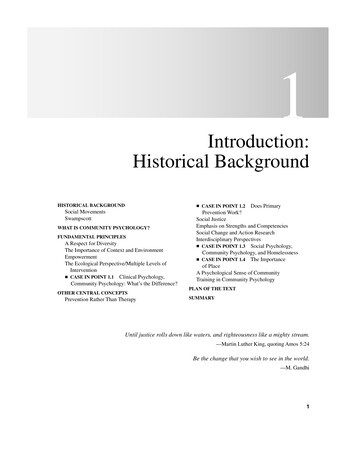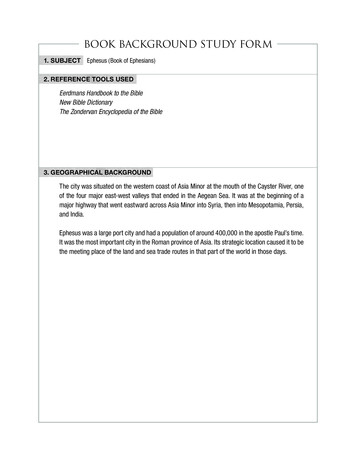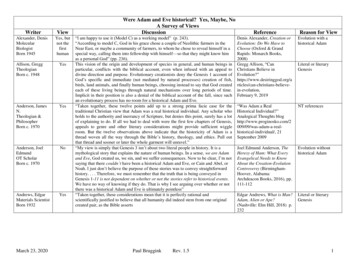
Transcription
M01 MORI5627 05 SE C01.indd Page 1 30/05/13/203/PH01348/9780205255627 MORITSUGU/MORITSUGU COMMUNITY PSYCHOLOGY5 SE 978020527:00 AM user-f-4011Introduction:Historical BackgroundHISTORICAL BACKGROUNDSocial MovementsSwampscottWHAT IS COMMUNITY PSYCHOLOGY?FUNDAMENTAL PRINCIPLESA Respect for DiversityThe Importance of Context and EnvironmentEmpowermentThe Ecological Perspective/Multiple Levels ofIntervention CASE IN POINT 1.1 Clinical Psychology,Community Psychology: What’s the Difference?OTHER CENTRAL CONCEPTSPrevention Rather Than Therapy CASE IN POINT 1.2 Does PrimaryPrevention Work?Social JusticeEmphasis on Strengths and CompetenciesSocial Change and Action ResearchInterdisciplinary Perspectives CASE IN POINT 1.3 Social Psychology,Community Psychology, and Homelessness CASE IN POINT 1.4 The Importanceof PlaceA Psychological Sense of CommunityTraining in Community PsychologyPLAN OF THE TEXTSUMMARYUntil justice rolls down like waters, and righteousness like a mighty stream.—Martin Luther King, quoting Amos 5:24Be the change that you wish to see in the world.—M. Gandhi1
M01 MORI5627 05 SE C01.indd Page 2 30/05/13/203/PH01348/9780205255627 MORITSUGU/MORITSUGU COMMUNITY PSYCHOLOGY5 SE 978020527:00 AM user-f-4012Part I Introductory ConceptsMy dog Zeke is a big, friendly Lab–golden retriever–Malamute mix. Weighing in at a little over 100 pounds,he can be intimidating when you first see him. Those who come to know him find a puppy-like enthusiasm and an eagerness to please those he knows.One day, Zeke got out of the backyard. He scared off the mail delivery person and roamed thestreets around our home for an afternoon. On returning home and checking our phone messages,we found that we had received a call from one of our neighbors. They had found Zeke about a blockaway and got him back to their house. There he stayed until we came to retrieve him. We thankedthe neighbor, who had seen Zeke walking with us every day for years. The neighbor, my wife, and Ihad stopped and talked many times. During those talks, Zeke had loved receiving some extra attention. Little did we know all this would lead to Zeke’s rescue on the day he left home.As an example of community psychology, we wanted to start with something to which we allcould relate. Community psychology is about everyday events that happen in all of our lives. It isabout the relationships we have with those around us, and how those relationships can help intimes of trouble and can enhance our lives in so many other ways. It is also about understandingthat our lives include what is around us, both literally and figuratively.But community psychology is more than a way to comprehend this world. Community psychologyis also about action to change it in positive ways. The next story addresses this action component.We start with two young women named Rebecca and Trisha, both freshmen at a large university.The two women went to the same high school, made similar grades in their classes, and stayed out oftrouble. On entering college, Rebecca attended a pre–freshman semester educational program onalcohol and drug abuse, which introduced her to a small group of students who were also enteringschool. They met an upperclassman mentor, who helped them with the mysteries of a new school andcontinued to meet with them over the semester to answer any other questions. Trisha did not receivean invitation and so did not go to this program. Because it was a large school, the two did not havemany opportunities to meet during the academic year. At the end of their first year, Rebecca and Trisharan into each other and compared stories about their classes and their life. As it turns out, Rebecca hada good time and for the most part stayed out of trouble and made good grades. Trisha, on the otherhand, had problems with her drinking buddies and found that classes were unexpectedly demanding.Her grades were lower than Rebecca’s even though she had taken a similar set of freshman classes.Was the pre-freshman program that Rebecca took helpful? What did it suggest for future work on drugand alcohol use on campuses? A community psychologist would argue that the difference in experiences was not about the “character” of the two women, but about how well they were prepared for thedemands of freshman life and what supports they had during their year. And what were those preparations and supports that seemed to bring better navigation of the first year in college?By the end of this chapter, you will be aware of many of the principles by which the two storiesmight be better understood. By the end of the text, you will be familiar with the concepts and the researchrelated to these and other community psychology topics and how they may be applied to a variety ofsystems within the community. These topics range from neighborliness to the concerns and crises thatwe face in each of our life transitions. The skills, knowledge, and support that we are provided by oursocial networks and the systems and contexts in which these all happen are important to our navigatingour life. A community psychology provides direction in how to build a better sense of community, how tocontend with stresses in our life, and how to partner with those in search of a better community. Theinterventions are usually alternatives to the traditional, individual-person, problem-focused methods thatare typically thought of when people talk about psychology. And the target of these interventions may beat the systems or policy level as well as at the personal. But first let us start with what Kelly (2006) wouldterm an “ecological” understanding of our topic—that is, one that takes into account both the history andthe multiple interacting events that help to determine the direction of a community.We first look at the historical developments leading up to the conception of community psychology. Wethen see a definition of community psychology, the fundamental principles identified with the field, and
M01 MORI5627 05 SE C01.indd Page 3 30/05/13/203/PH01348/9780205255627 MORITSUGU/MORITSUGU COMMUNITY PSYCHOLOGY5 SE 978020527:00 AM user-f-401Chapter 1 Introduction: Historical Background3other central concepts. We learn of a variety of programs in community psychology. And finally, a cognitive map for the rest of the text is provided. But first, back to the past.HISTORICAL BACKGROUNDShakespeare wrote, “What is past is prologue.” Why gain a historical perspective? Because the past provides the beginning to the present and defines meanings in the present. Think of when someone says“Hi” to you. If there is a history of friendship, you react to this act of friendship positively. If you haveno history of friendship, then you wonder what this gesture means and might react with more suspicion.In a similar way, knowing something of people’s developmental and familial backgrounds tells us something about what they are like and what moves them in the present. The history of social and mentalhealth movements provides insight into the state of psychology. These details provide us with information on the spirit of the times (zeitgeist) and the spirit of the place (ortgeist) that brought forth a community psychology “perspective” (Rappaport, 1977) and “orientation” (Heller & Monahan, 1977).These historical considerations have been a part of community psychology definitions ever sincesuch definitions began to be offered (Cowen, 1973; Heller & Monahan, 1977; Rappaport, 1977). Theyalso can be found in the most recent text descriptions (Kloos et al., 2011; Nelson & Prilleltensky, 2010).A community psychology that values the importance of understanding “context” would appreciate theneed for historical background in all things (Trickett, 2009). This understanding will help explain whythings are the way they are, and what forces are at work to keep them that way or to change them. Wealso gain clues on how change has occurred and how change can be facilitated.So what is the story? We will divide it into a story of mental health treatment in the United Statesand a story of the social movements leading up to the founding of the U.S. community psychology field.In colonial times, the United States was not without social problems. However, given the close-knit,agrarian communities that existed in those times, needy individuals were usually cared for without specialplaces to house them (Rappaport, 1977). As cities grew and became industrialized, people who were mentally ill, indigent, and otherwise powerless were more and more likely to be institutionalized. These earlyinstitutions were often dank, crowded places where treatment ranged from restraint to cruel punishment.In the 1700s France, Philip Pinel initiated reforms in mental institutions, removing the restraints placedon asylum inmates. Reforms in America have been attributed to Dorothea Dix in the late 1800s. Her careerin nursing and education eventually led her to accept an invitation to teach women in jails. She noted that theconditions were abysmal and many of the women were, in fact, mentally ill. Despite her efforts at reform,mental institutions, especially public ones, continued in a warehouse mentality with respect to their charges.These institutions grew as the lower class, the powerless, and less privileged members of society were conveniently swept into them (Rappaport, 1977). Waves of early immigrants entering the United States wereoften mistakenly diagnosed as mentally incompetent and placed in the overpopulated mental “hospitals.”In the late 1800s, Sigmund Freud developed an interest in mental illness and its treatment. You mayalready be familiar with the method of therapy he devised, called psychoanalysis. Freud’s basic premisewas that emotional disturbance was due to intrapsychic forces within the individual caused by past experiences. These disturbances could be treated by individual therapy and by attention to the unconscious.Freud gave us a legacy of intervention aimed at the individual (rather than the societal) level. Likewise, heconferred on the profession the strong tendency to divest individuals of the power to heal themselves; thephysician, or expert, knew more about psychic healing than did the patient. Freud also oriented professional healers to examine an individual’s past rather than current circumstances as the cause of disturbance, and to view anxiety and underlying disturbance as endemic to everyday life. Freud certainlyconcentrated on an individual’s weaknesses rather than strengths. This perspective dominated Americanpsychiatry well into the 20th century. Variations of this approach persist to the present day.
M01 MORI5627 05 SE C01.indd Page 4 30/05/13/203/PH01348/9780205255627 MORITSUGU/MORITSUGU COMMUNITY PSYCHOLOGY5 SE 978020527:00 AM user-f-4014Part I Introductory ConceptsIn 1946, Congress passed the National Mental Health Act. This gave the U.S. Public Health Service broad authority to combat mental illness and promote mental health. Psychology had proved usefulin dealing with mental illness in World War II. After the war, recognition of the potential contributionsof a clinical psychology gave impetus to further support for its development. In 1949, the National Institute of Mental Health (NIMH) was established. This organization made available significant federalfunding for research and training in mental health issues (Pickren, 2005; Schneider, 2005).At the time, clinical psychologists were battling with psychiatrists to expand their domain fromtesting, which had been their primary thrust, to psychotherapy (Walsh, 1987). Today, clinical psychology is the field within psychology that deals with the diagnosis, measurement, and treatment of mentalillness. It differs from psychiatry in that psychiatrists have a medical degree. Clinical psychologistshold doctorates in psychology. These are either a PhD, which is considered a research degree, or a PsyD,which is a “practitioner–scholar” degree focused on assessment and psychological interventions. (Today,the practicing “psychologist,” who does therapy, includes a range of specialties. For example, counseling psychologists, who also hold PhD or PsyD degrees, have traditionally focused on issues of personaladjustment related to normal life development. They too are found among the professional practitionersof psychology.) The struggle between the fields of psychiatry and psychology continues today, as somepsychologists seek the right to prescribe medications and obtain practice privileges at the hospitals thatdo not already recognize them (Sammons, Gorny, Zinner, & Allen, 2000). New models of “integratedcare” have been growing, where physicians and psychologists work together at the same “primary care”site (McGrath & Sammons, 2011).Another aspect of the history of mental health is related to the aftermath of the two world wars. Formerly healthy veterans returned home as psychiatric casualties (Clipp & Elder, 1996; Rappaport, 1977;Strother, 1987). The experience of war itself had changed the soldiers and brought on a mental illness.In 1945, the Veterans Administration sought assistance from the American Psychological Association (APA) to expand training in clinical psychology. These efforts culminated in a 1949 conference inBoulder, Colorado. Attendees at this conference approved a model for the training of clinical psychologists(Donn, Routh, & Lunt, 2000; Shakow, 2002). The model emphasized education in science and the practiceof testing and therapy, a “scientist–practitioner” model.The 1950s brought significant change to the treatment of mental illness. One of the most influential developments was the discovery of pharmacologic agents that could be used to treat psychosis andother forms of mental illness. Various antipsychotics, tranquilizers, antidepressants, and other medications were able to change a patient’s display of symptoms. Many of the more active symptoms weresuppressed, and the patient became more tractable and docile. The use of these medications proliferateddespite major side effects. It was suggested that with appropriate medication, patients would not requirethe very expensive institutional care they had been receiving, and they could move on to learning how tocope with and adjust to their home communities, to which they might return. Assuming adequateresources, the decision to release patients back into their communities seemed more humane. There wasalso a financial argument for deinstitutionalization, because the costs of hospitalization were high. Therewas potential for savings in the care and management of psychiatric patients. The focus for dealing withthe mentally ill shifted from the hospital to the community. Unfortunately, what was forgotten was theneed for adequate resources to achieve this transition.In 1952, Hans Eysenck, Sr., a renowned British scientist, published a study critical of psychotherapy (Eysenck, 1952, 1961). Reviewing the literature on psychotherapy, Eysenck found that receivingno treatment worked as well as receiving treatment. The mere passage of time was as effective in helpingpeople deal with their problems. Other mental health professionals leveled criticisms at psychological practices, such as psychological testing (Meehl, 1954, 1960) and the whole concept of mentalillness (Elvin, 2000; Szasz, 1961). (A further review of these issues and controversies can be found.)
M01 MORI5627 05 SE C01.indd Page 5 30/05/13/203/PH01348/9780205255627 MORITSUGU/MORITSUGU COMMUNITY PSYCHOLOGY5 SE 978020527:00 AM user-f-401Chapter 1 Introduction: Historical Background5If intervention was not useful, as Eysenck claimed, what would happen to mentally ill individuals?Would they be left to suffer because the helping professions could give them little hope? This was thedilemma facing psychology.In the 1950s and 1960s, Erich Lindemann’s efforts in social psychiatry had brought about a focuson the value of crisis intervention. His work with survivors of the Cocoanut Grove fire in Boston demonstrated the importance of providing psychological and social support to people coping with life tragedies. With adequate help provided in a timely manner, most individuals could learn to deal with theircrises. At the same time, the expression of grief was seen as a natural reaction and not pathological. Thisemphasis on early intervention and social support proved important to people’s ability to adapt.Parallel to these developments, Kurt Lewin and the National Training Laboratories were studyinggroup processes, leadership skills for facilitating change, and other ways in which social psychologycould be applied to everyday life (www.ntl.org/inner.asp?id 178&category 2). There was a growingunderstanding of the social environment and social interactions and how they contributed to group andindividual abilities to deal with problems and come to healthy solutions.As a result, the 1960s brought a move to deinstitutionalize the mentally ill, releasing them back intotheir communities. Many questioned the effectiveness of traditional psychotherapy. Studies found that earlyintervention in crises was helpful. And psychology grew increasingly aware of the importance of socialenvironments. Parallel to these developments, social movements were developing in the larger community.Social MovementsAt about the same time as Freud’s death (1930s), President Franklin D. Roosevelt proclaimed his NewDeal. Heeding the lessons of the Great Depression of the 1920s and 1930s, he experimented with a widevariety of government regulatory reforms, infrastructure improvements, and employment programs.These efforts eventually included the development of the Social Security system, unemployment anddisability benefits, and a variety of government-sponsored work relief programs, including ones linkedto the building of highways, dams, and other aspects of the nation’s economic infrastructure. One greatexample of this was the Tennessee Valley Authority, which provided a system of electricity generation,industry development, and flood control to parts of Tennessee, Alabama, Mississippi, Kentucky, Virginia, Georgia, and North Carolina. This approach greatly strengthened the concept of government as anactive participant in fostering and maintaining individuals’ economic opportunities and well-being(Hiltzik, 2011). Although the role of government in fostering well-being is debated to this day, newerconceptions of the role of government still include an active concern for equal opportunity, strategicthinking, and the need for cooperation and trust (Liu & Hanauer, 2011).There were other social trends as well. Although women had earlier worked in many capacities,the need for labor during World War II allowed them to move into less traditional work settings. “Rosiethe Riveter” was the iconic woman of the time, working in a skilled blue-collar position, doing dangerous, heavy work that had previously been reserved for men in industrial America. After the war, it wasdifficult to argue that women could not work outside the home, because they had contributed so much toAmerican war production. This was approximately 20 years after women had gained voting rights at thenational level, with the passage of the 19th Amendment to the Constitution (passing Congress in 1919and taking until 1920 for the required number of states to ratify it). Throughout the 1950s, 1960s, and1970s, women—once disenfranchised as a group and with limited legal privileges—continued to seektheir full rights as members of their communities.In another area of social change, the U.S. Supreme Court in 1954 handed down their decision inBrown v. Board of Education of Topeka, Kansas. This decision overturned an earlier ruling that racialgroups could be segregated into “separate but equal” facilities. In reality, the segregated facilities were
M01 MORI5627 05 SE C01.indd Page 6 30/05/13/203/PH01348/9780205255627 MORITSUGU/MORITSUGU COMMUNITY PSYCHOLOGY5 SE 978020527:00 AM user-f-4016Part I Introductory Conceptsnot equivalent. School systems that had placed Blacks into schools away from Whites were found to bein violation of the U.S. Constitution. This change in the law was a part of a larger movement by Blacksto seek justice and their civil rights. Notably, psychologists Kenneth and Mamie Phipps Clark providedpsychological research demonstrating the negative outcomes of segregated schools (Clark, 1989; Clark& Clark, 1947; Keppel, 2002). This was the first time that psychological research was used in a SupremeCourt decision (Benjamin & Crouse, 2002). The Brown v. Board of Education decision required sweeping changes nationally and encouraged civil rights activists.Among these activists were a tired and defiant Rosa Parks refusing to give up her bus seat to aWhite passenger as the existing rules of racial privilege required; nine Black students seeking entry intoa school in Little Rock, Arkansas; other Blacks seeking the right to eat at a segregated lunch counter; andstudents and religious leaders around the South risking physical abuse and death to register Blacks tovote. The civil rights movement of the 1950s carried over to the 1960s. People of color, women, andother underprivileged members of society continued to seek justice. The Voting Rights Act of 1965helped to enforce the 15th Amendment to the Constitution, guaranteeing citizens the right to vote (www.ourdocuments.gov/doc.php?flash true&doc 100&page transcript).In the 1960s, the “baby boomers” also came of age. Born in the mid-1940s and into the 1960s,these children of the World War II veterans entered the adult voting population in the United States inlarge numbers, shifting the opinions and politics of that time. Presaging these changing attitudes,in 1960, John F. Kennedy was elected president of the United States . Considered by some too young and too inexperienced to be president, Kennedyembodied the optimism and empowerment of an America that had won a world war and had openededucational and occupational opportunities to the generation of World War II veterans and their families (Brokaw, 1998). His first inaugural address challenged the nation to service, saying, “Ask not whatyour country can do for you—ask what you can do for your country.” During his tenure, the PeaceCorps was created, sending Americans overseas to help developing nations to modernize. Psychologists were also encouraged to “do something to participate in society” (Walsh, 1987, p. 524). Thesesocial trends, along with the increasing moral outrage over the Vietnam War, fueled excitement overcitizen involvement in social reform and generated an understanding of the interdependence of socialmovements (Kelly, 1990).One of President Kennedy’s sisters had special needs. This may have fueled his personal interestin mental health issues. Elected with the promise of social change, he endorsed public policies based onreasoning that social conditions, in particular poverty, were responsible for negative psychological states(Heller, Price, Reinharz, Riger, & Wandersman, 1984). Findings of those times supported the notion thatpsychotherapy was reserved for a privileged few, and institutionalization was the treatment of choice forthose outside the upper class (Hollingshead & Redlich, 1958). In answer to these findings, Kennedyproposed mental health services for communities and secured the passage of the Community MentalHealth Centers Act of 1963. The centers were to provide outpatient, emergency, and educational services, recognizing the need for immediate, local interventions in the form of prevention, crisis services,and community support.Kennedy was assassinated at the end of 1963, but the funding of community mental health continued into the next administration. In his 1964 State of the Union address, President Lyndon B. Johnsonprescribed a program to move the country toward a “Great Society” with a plan for a “War on Poverty.”President Johnson wanted to find ways to empower people who were less fortunate and to helpthem become productive citizens. Programs such as Head Start (addressed in Chapter 8) and otherfederally funded early childhood enhancement programs for the disadvantaged were a part of theseefforts. Although much has changed in our delivery of social and human services since the 1960s, manyof the prototypes for today’s programs were developed during this time.
M01 MORI5627 05 SE C01.indd Page 7 30/05/13/203/PH01348/9780205255627 MORITSUGU/MORITSUGU COMMUNITY PSYCHOLOGY5 SE 978020527:00 AM user-f-401Chapter 1 Introduction: Historical Background7Multiple forces in mental health and in the social movements of the time converged in the mid1960s. Dissatisfaction with the effectiveness of traditional individual psychotherapy (Eysenck, 1952),the limitation on the number of people who could be treated (Hollingshead & Redlich, 1958), and thegrowing number of mentally ill individuals returning into the communities combined to raise seriousquestions regarding the status quo in mental health. In turn, a recognition of diversity within our population, the appreciation of the strengths within our communities, and a willingness to seek systemic solutions to problems directed psychologists to focus on new possibilities in interventions. Thus we have thebasis for what happened at the Swampscott Conference.SwampscottIn May 1965, a conference in Swampscott, Massachusetts (on the outskirts of Boston), was convenedto examine how psychology might best plan for the delivery of psychological services to Americancommunities. Under the leadership of Don Klein, this training conference was organized and supportedby the National Institute of Mental Health (NIMH; Kelly, 2005). Conference participants, includingclinical psychologists concerned with the inadequacies of traditional psychotherapy and oriented tosocial and political change, agreed to move beyond therapy to prevention and the inclusion of an ecological perspective in their work (Bennett et al., 1966). The birth of community psychology in the UnitedStates is attributed to these attendees and their work (Heller et al., 1984; Hersch, 1969; Rappaport, 1977).Appreciating the influence of social settings on the individual, the framers of the conference proceedingsproposed a “revolution” in the theories of and the interventions for a community’s mental health (Bennettet al., 1966).WHAT IS COMMUNITY PSYCHOLOGY?Community psychology focuses on the social settings, systems, and institutions that influence groupsand organizations and the individuals within them. The goal of community psychology is to optimize thewell-being of communities and individuals with innovative and alternate interventions designed in collaboration with affected community members and with other related disciplines inside and outside ofpsychology. Klein (1987) recalled the adoption of the term community psychology for the 1963 Swampscott grant proposal to NIMH. Klein credited William Rhodes, a consultant in child mental health, forwriting of a “community psychology.” Just as there were communities that placed people at risk ofpathology, community psychology was interested in how communities and the systems within themhelped to bring health to community members.Iscoe (1987) later tried to capture the dual nature of community psychology by drawing a distinction between a “community psychology” and a “community psychologist.” He stated that the field ofcommunity psychology studied communities and the factors that made them healthy or at risk. In turn, acommunity psychologist used these factors to intervene for the betterment of the community and theindividuals within it. In the 1980s, the then Division of Community Psychology (Division 27 of theAPA): was renamed the Society for Community Research and Action so as to better emphasize the dualnature of the field.The earliest textbook (Rappaport, 1977) defined community psychology asan attempt to find other alternatives for dealing with deviance from societal-based norms . . .[avoiding] labeling differences as necessarily negative or as requiring social control . . . [and attempting] to support every person’s right to be different without risk of suffering material and psychological sanctions . . . The defining aspects of this [community] perspective are: cultural relativity,diversity, and ecology, [or rather] the fit between person and environment . . . [The] concerns [of a
M01 MORI5627 05 SE C01.indd Page 8 30/05/13/203/PH01348/9780205255627 MORITSUGU/MORITSUGU COMMUNITY PSYCHOLOGY5 SE 978020527:00 AM user-f-4018Part I Introductory ConceptsTABLE 1.1Four Broad Principles Guiding Community Research and Action1. Community research and action requires explicit attention to and respect for diversity amongpeoples and settings.2. Human competencies and problems are best understood by viewing people within their social,cultural, economic, geographic, and historical contexts.3. Community research and action is an active collaboration among researchers, practitioners,and community members that uses multiple methodologies. Such research and action must beundertaken to serve those community members directly concerned, and should be guided by theirneeds and preferences, as well as by their active participation.4. Change strategies are needed at multiple levels to foster settings that promote competence andwell-being.Source: From www.scra27.org/about.html.community psychology reside in] human resource development, politics, and science . . . to theadvantage of the larger community and its many sub-communities. (pp. 1, 2, 4–5; boldface ours)This emphasis on an alternative to an old, culture-blind, individual-focused perspective wasrestated more recently in Kloos and colleagues (2011), who provide two ways in which communitypsychology is distinctive. It “offers a different way of thinking about human behavior . . . [with a]focus on the community contexts of behavior; and
The history of social and mental health movements provides insight into the state of psychology. These details provide us with informa-tion on the spirit of the times (zeitgeist) and the spirit of the place (ortgeist) that brought forth a com-munity psychology “perspective” ( Rappaport,











